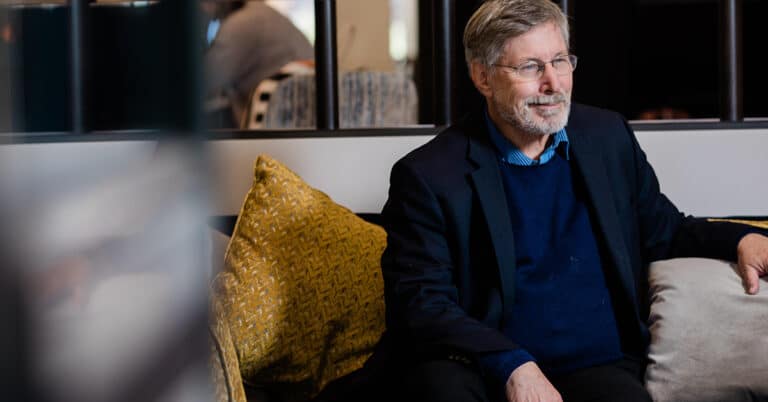
Image by Gary Ellis/Getty Images, © All Rights Reserved.
Why Anxiety Is So Persuasive — and Pervasive
A while back, I asked readers to suggest subjects for me to explore in this column, and the immediate request was that I write about anxiety. Most people believe that we live in especially anxious times. Everywhere I teach, people describe how the mounting anxieties of modern life exhaust them. They want help to remain calm and confident amid so much perceived danger.
This is the first of two columns about anxiety. In this one I hope to help readers understand why anxiety is so persuasive and pervasive and draw a distinction between fear and anxiety. In my next column, I will offer some techniques for coping and describe a few approaches to help you live a life that keeps anxiety in perspective.
My dear friend Sylvia Boorstein jokes that she is a recovering catastrophizer. Anxiety is her default energy. “When in doubt, worry,” she says.
“If there is the slightest ambiguity, worry. I phone my son and he doesn’t answer. He must be dead. Now, there could be a thousand reasons he is not answering the phone. He’s in the shower. He fell in love. He’s sleeping. But my mind goes to the worst extrapolation of that. Anxiety is the free-floating hyperactivity of the mind that only wants to consider the worst possible outcome.”
Free-floating hyperactivity of the mind is a brilliant and funny description. I would add to that how anxiety intensifies, building one conjecture upon the next. It can be very harsh. You feel bad about having anxiety, and it gets stronger. You feel it will never end, and it gets stronger. In Buddhist psychology, we use the verb “proliferate,” which means to reproduce rapidly. I picture anxiety like those animations of cells dividing exponentially, simultaneously spreading out and growing taller. The same is true for our anxieties. A friend sent me an old Peanuts cartoon of Charlie Brown sitting up in bed in the middle of the night saying, “My anxieties have anxieties.” That captures the proliferation of anxieties perfectly.
Everyone feels some anxiety at times. If I ask participants in my seminars who among them suffers from anxiety, almost every hand goes up. In one way, anxiety is essential to live. We need a few basics to survive: food, water, and shelter. Sustaining those three essentials requires vigilance, but not the frantic hyper-vigilance that comes with anxiety. Anxiety accelerates you — heightens awareness, focuses the senses and alerts the reflexes. If these are all aroused because of a genuine threat, they form a particular intelligence in response to fear. When those senses are piqued by imaginary threats, we become consumed by anxiety.
To cope, we need to learn to distinguish anxiety from a more realistic fear.
Fear is immediate, a threat right in front of you that requires a swift response. Sylvia’s example is finding yourself driving through a blinding snowstorm that prevents you from seeing even a few feet ahead. Without needing to think, all your senses focus so that you can respond in a way that ensures your survival and that of the other people in the car. When Sylvia’s son did not answer the phone, her imagination quickly thought up frightening scenarios. Her eyes widened and her heart raced as she escalated into a state of hyper-alertness even though all of this was taking place in her imagination. The fact that anxiety grips the body in the same way as fear gives anxiety more credibility than it deserves. When your body reacts this way, it believes anxiety is alerting you to a genuine threat.
When the brain is spinning out one horrifying outcome after another, it does not have enough space to clearly perceive the world around us as it is in this moment. If a big energy is trying to move through a constricted space it can give us the feeling that we are bouncing off the walls, and our thoughts ricochet inside our heads creating a frenzy that is a danger of its own.
So distracted are we by thoughts of what might happen, we cannot appreciate the circumstances here and now. We cannot move through the world in a constant state of self-generated fear.
The woman who wrote to me asking that I address anxiety described her struggle like this: Her anxiety was wrapped around perfectionism. Misty, as she invited me to call her, was a high-achieving woman who always wanted to appear to be the embodiment of perfection. An attitude like that is often founded in feelings of worthlessness, as it was with Misty. She always felt, no matter how much success she achieved, that she needed to do more to feel that her life had value.
This anxiety included her appearance. Misty was an obsessive early morning gym rat who worked out intensely and was also very careful about food. If she missed a single workout or had a smidgen of an unplanned treat, she became off-balance. She wrote that deviating even a small amount from her rigid schedule made her even more anxious. Her constant feeling was that if she had one small lapse, that lapse would signify the beginning of a full collapse and all would be lost. She would be revealed to the world — and to herself — not to be the perfect person who deserved all this success. When Misty began to recognize that her misery was thus created and reinforced, she understood that her fears were not based on real threats to her life, but on ones she conjured and held close.
Distinguishing anxiety from a more realistic fear was a key insight for Misty. It caused her to re-evaluate the way she was spending her time. She was burnt out by the constant imperatives that ruled her life, and she knew that something had to change if she was to find balance.
In truth, nothing in life is a straight shot — she understood that well. We go forward, we fall down, we have to pick ourselves up or let someone help us up — we go forward again. That’s how change happens, that’s how progress is made — through resilient effort, not through self-punishment or hyper frantic judgment. We might deeply know that, but we tend to forget it.

